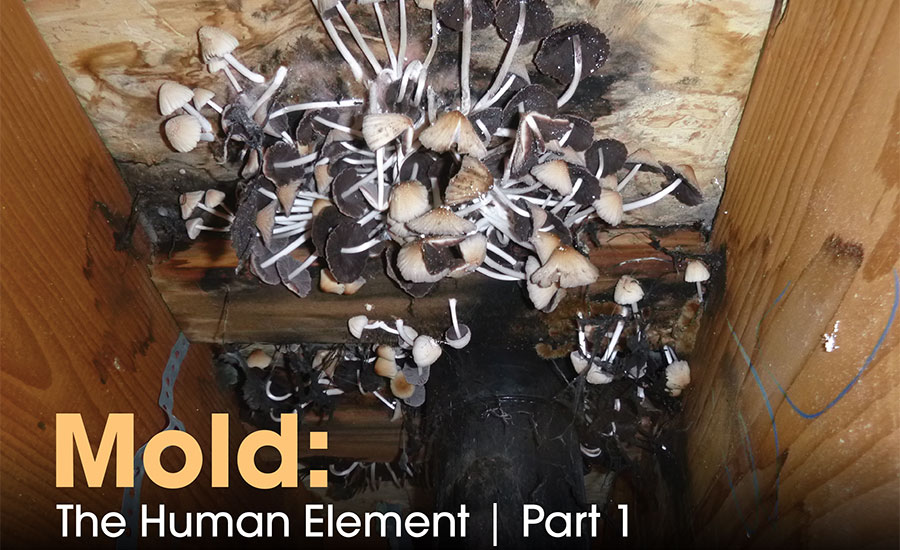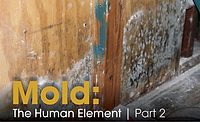Mold: The Human Element | Part 1
Homeowners, tenants, and shared responsibility when handling multi-family losses.

Crews discovered this upon opening a ceiling below another unit, showing shared responsibility. Photos courtesy of ASR
Remediation. Mitigation. Abatement. All great words to use with our customers when describing how to eliminate their mold problem. We use all the knowledge gleaned through years of experience and education, reference standards of care, and talk about spore counts. Then, if their head isn’t spinning enough yet, we explain to the average homeowner how the structure of mold can affect them in different ways, using big words like sporulation and mycotoxins. Rather than breed confidence in our services, these scenarios often incite fear in the homeowner.
Don’t get me wrong, I feel educated conversation is the best way to sell our services. We are obviously in this industry to make money and we can go on for hours trying to impress Mr. or Mrs. Homeowner with our perceived wisdom, convincing them that we are the answer to all of their mold dilemmas. We can use these big words and try to convince them we are smarter than them when it comes to microbiology, mold remediation, and water damaged buildings. However, after all the big words and scientific data, at the core of all this we are dealing with human beings. Regardless of whether they have insurance or not, regardless of whether they are wealthy or not, we are all just human. With that come numerous factors which can completely change the dynamic of our plan or sales pitch and adapt to each customer – each human.

Mold was discovered after doing a packout at the home of a hoarder. Photos courtesy of ASR.
The Homeowner and the Tenant
The most common relationship we run into is between homeowner and tenant. From a great relationship to a tumultuous battleground and everything in between. The homeowner has his/her interests and the tenants have theirs. Homeowners need to consider the value of the home, the cost of the problem, and (hopefully) the impact on the tenant. They are the ones paying for this project and possibly utilizing their insurance policy. The tenants are the ones who are forced to live there during this disruption. They may have families, pets, and expenses of their own they incur. If you are remediating a kitchen or bathroom, they may have to relocate while the work is done.
While tenants do have rights, many feel they are entitled to certain things such as compensation. The most common thing I hear when a tenant feels a mold problem exists is “I haven’t been feeling well lately” or “I’ve been to the doctor and they said it could be from mold.”

Mold on this common wall between two separate units of an HOA shows how multiple stakeholders can be involved. Photos courtesy of ASR.
Some of us immediately roll our eyes upon hearing this and put up a wall of avoidance because we don’t want to get involved with that dispute. But the reality is that mold can affect people in different ways. We know children and the elderly are more susceptible than most. We immediately worry more if the resident mentions they have a condition that makes them immune-compromised. I am a 39-year-old male in reasonably good shape, yet if I am around mold without my respirator for even a short amount of time, it is guaranteed I will have a nagging headache the rest of the day.
Within the last two decades, the medical field has come a long way linking mold exposure to health problems. All we used to hear about were asthma and allergies. Now they have begun to link poisoning of mold toxins to neurological problems such as depression. The health impacts being discussed are increasing constant and while we want to avoid involvement in that discussion between the homeowner and tenant, the issue will still exist. The correct answer as we all know is: “I am not a doctor, you should discuss this with a medical professional.”
Still, you are involved in the problem at hand which is creating this conversation and the work you do will have a big impact on it. You might be able to avoid the medical conversation in the beginning, but if you don’t do your job right you can bet you will be dragged into the conversation again, only this time you could be looked at as a culprit instead of a consultant. Legal ramifications could follow. So as mold remediation professionals, we need to remain educated and aware of these health concerns, even if we can’t give medical advice.

This is a great example of HOA/homeowner shared responsibility, with the cabinet and flooring being homeowner, and the drywall being HOA. Photos courtesy of ASR.
Shared Responsibility
Something else that can come into play is the element of shared responsibility. While the usual thought process of a tenant is that they are just tenants and a problem with the house is the owner’s responsibility, they can be held responsible as well in some instances. They could own the appliance that caused the damage. They could know about mold damage for weeks, months, or even years but neglect to inform the owner. There could be contents impacted that are the tenant’s responsibility even though the source and structural impact is the owner’s responsibility. This could lead to a financial stalemate between the owner and the tenant, which holds you up from doing the work. It could result in an eviction situation which potentially holds up the project as well.
There could also be insurance companies involved on both sides that aren’t agreeing on several aspects of the project and during this argument the problem is only getting worse. There might not be insurance coverage at all, and neither party can afford the expense. These problems amplify when the owner is a mold minimizer, yet the tenant is fungi-phobic.

This is the impact to a bathroom ceiling that a tenant never reported to a homeowner. Photos courtesy of ASR.
Taking all of this into consideration, your job is to come up with a solution that is satisfactory to both the owner and the tenant. This solution should be practical and ethical. Usually the best approach is to limit what you tell the tenant and focus your recommendations to the homeowner and adjuster. This may not be as easy to do as it sounds, though. Remember, the tenant will likely be living there during the remediation and can easily become exposed to your work no matter how careful you are. We can build the best containments and have plenty of air exchanges, preventing any conceivable cross-contamination. But we have all experienced that curious and litigious tenant who somehow winds up in your containments after you have turned your back or have left the worksite. When you are dealing with a project involving a tenant and a homeowner, your documentation has to be twice as good as normal. On more than one occasion, I have gone as far as having contracts for each party, outlining the specific details that affect them individually.
Coming next month in part two, we are going to dive deeper into the importance of proper communication, especially when it comes to those who are mold-sensitized, as well as how to educate customers who believe they already know it all, and dealing with third parties.
Looking for a reprint of this article?
From high-res PDFs to custom plaques, order your copy today!








